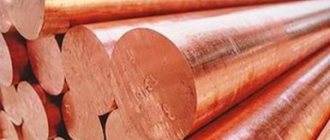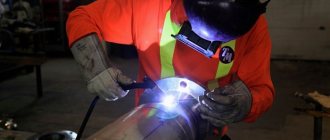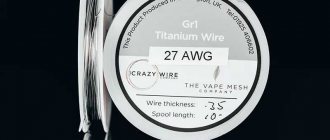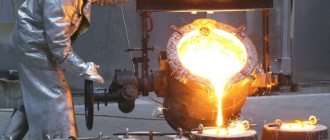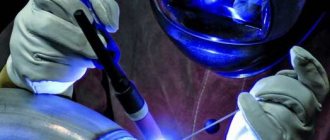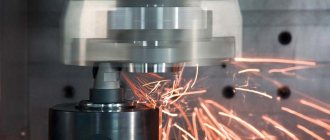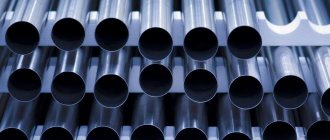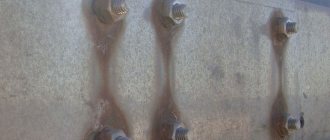Why does stainless steel rust? Causes of stainless steel corrosion
The occurrence of rust on stainless steel confuses many people. If the material is called “stainless steel,” then why can stainless steel oxidize, darken, blacken and rust? In fact, if the part is not processed correctly or is not used properly, rust can appear even on the highest quality stainless steel.
If the stainless steel contains no more than 10% chromium, then it is almost impossible to exclude the occurrence of corrosion. Even on the surface of austenitic steel, which contains 20% chromium and 8% nickel, rust can form. In order to extend the life of a stainless steel part, it is necessary to understand how to use the material correctly and prevent the occurrence of structural defects.
Which “stainless” steel will not rust?
You can reduce the risk and prevent rusting on stainless steel by adding special chemical elements to the alloy: these can be chromium, nickel, tungsten, vanadium, molybdenum, silicon, manganese, titanium. Such steel will be called alloy steel. Changing the alloy composition leads to an improvement in the physical properties of steel. The alloyed material acquires qualities that ordinary carbon steel does not have and gets rid of its disadvantages. With proper use, this stainless steel will not rust. Finished stainless steel products are safe for use even in the food and medical fields; such products are environmentally friendly and meet all safety requirements.
Depending on the proportions of additives, low-alloy, medium-alloy and high-alloy steel are distinguished. High alloy steel is the most popular option for use in various industries. The alloy resists corrosion of stainless steel in aggressive environments and atmospheres. Alloying additives give improved qualities to the metal, primarily chromium and nickel. The grade of stainless steel, its anti-corrosion properties and appearance depend on the percentage of chemical elements contained.
Austenitic stainless steel.
Steels of this group are widely used in industry for the manufacture of fasteners. The alloy is non-magnetic. Can be welded and heat treated well. The composition may contain 15-20% chromium and 5-15% nickel. The percentage of additives depends on the grade of stainless steel.
Ferritic grades of stainless steel.
Due to their low carbon content, ferritic steels become softer and more ductile. Alloys of this group have magnetic properties. They are often used for the manufacture of parts that interact with aggressive environments, because... Ferritic alloys have a high level of resistance to corrosion.
Martensitic grades of stainless steel.
A group of alloys with a high carbon content, which makes steel the most durable and hard. Some brands may be magnetic. This group is the least corrosion resistant. Used, for example, to make cutlery and cutlery.
Combined brands.
This group of steels combines the advantages of several groups at once.
Advantages of stainless steels:
- Long service life with proper use;
- Ease of manufacture;
- Corrosion resistance;
- Strength;
- Hygiene and environmental safety;
- Aesthetic appearance.
In what areas of industry is stainless steel used?
- Architecture and construction;
- Manufacturing of household appliances;
- Food industry;
- Pulp and paper production;
- Petrochemical and chemical industry;
- Household;
- Energy;
- Environmental protection;
- Mechanical engineering.
TO
The high corrosion resistance of stainless steels is determined by their ability to be easily passivated even in normal atmospheres. conditions due to oxygen in the air. This property depends on the content of chromium - the main alloying element of stainless steels. The lowest chromium content that provides steel with a passive state is 12%. With increasing chromium content, the corrosion resistance of stainless steels under oxidizing conditions increases sharply. Nickel also contributes to the passivation of stainless steels, but to a much lesser extent. The corrosion resistance of stainless steels is also highly dependent on carbon content; As a rule, with an increase in its content, the corrosion resistance of stainless steels decreases significantly. To impart high corrosion resistance, in some cases stainless steels are additionally alloyed with molybdenum, copper, titanium, niobium and other elements.The corrosion resistance of stainless steels depends on the structural condition.
Solid solutions alloyed with chromium and nickel have the greatest corrosion resistance. All factors that increase the heterogeneity of the structure of stainless steels with the formation of chromium carbides, nitrides and intermetallic compounds lead to a decrease in the concentration of chromium in the solid solution and a decrease in the corrosion resistance of stainless steels. The corrosion resistance of stainless steels is determined by the stability of the passive film and depends on the nature of the aggressive environment.
As a rule, in oxidizing environments, stainless steels have high corrosion resistance, and in non-oxidizing aqueous environments, the corrosion rate of stainless steels is high and increases with increasing chromium content, since chromium under these conditions is thermodynamically unstable due to the destruction of the passive film. Thus, stainless steels are stable in solutions of nitric acid, various neutral and weakly acidic solutions with access to oxygen, and are unstable in hydrochloric, sulfuric and hydrofluoric acids.
Recently, it has been established that stainless steels also lose their stability in strongly oxidizing environments due to the destruction of passive films at high redox levels. potential of the environment.
The passive state of stainless steels occurs at a certain potentials and rates of cathodic reaction.
For the passive state of any metal, including stainless steels, to occur, it is necessary that oxidation-reduction occurs. the potential of the medium, and therefore the potential of the cathodic reaction, exceeded the values of the first critical value. anodic passivation potential of the metal and that the cathodic current (rate of the cathodic process) exceeds the critical density value. anodic passivation current. Failure to comply with these conditions leads to an active state, and stainless steel rapidly dissolves. The conditions for the passivity of stainless steels are provided in oxidizing environments, and the conditions for the active state are in reducing or weakly oxidizing environments. environments, which corresponds to experimental data on the corrosion resistance of stainless steels in various environments. The higher the chromium content, the more negative the passivation potential and the lower the current density of anodic passivation of stainless steels. The indicated electrochemical parameters characterize the tendency of stainless steels to passivation.
During the transition from an active state to a passive state, an unstable state may be noted on steels, and depending on the influence of various factors, the metal can achieve complete passivity or again transition to an active state. Complete passivity of steels is achieved at higher potentials, which depend on the composition of the steels, and in some cases on the composition of the solution (for example, the presence of activators). It has been established that the passive state of stainless steels can be disrupted by anodic polarization at a high potential or by creating strongly oxidizing conditions with high redox conditions. potential of the environment.
The different states of stainless steels (active, passive, unstable and overpassivation state) can be clearly shown using potentiostatic. diagrams of corrosion rate - potential or anodic current density - potential, this means a current equivalent to the corrosion rate without taking into account the current spent on the evolution of hydrogen in the region is strongly negative. potentials or the release of oxygen in the region of highly positive potentials.
In the active region and the repassivation region, the corrosion rate of stainless steels increases with increasing potential in accordance with the electrochemical law. kinetics. In the unstable region, on the contrary, the corrosion rate of stainless steels decreases with increasing potential, which is associated with the gradual passivation of the surface of stainless steels. Once complete passivation is achieved, the corrosion rate of stainless steels is practically independent of potential.
The corrosion resistance of stainless steels is determined by the value of the stationary potential and its location in relation to the critical values. potentials. The value of the stationary potential corresponds to the point of intersection of the cathode curve with the anodic polarization curve. With the help of polarizers. diagrams can show all three main ones. states (active, passive, repassivation state) that determine the electrochemical. th corrosion behavior of stainless steel.
The rate of corrosion depends not only on the composition of the steel, but also on the pH value, the nature and concentration of activators, internal and externally applied stresses, temperature, and inhibitors present. Depending on these factors, the critical values change. potentials, as well as anodic current densities, equivalent to the corrosion rate, i.e. potentiostatic. diagrams can shift in coordinates; corrosion rate - potential. Thus, with an increase in the concentration of activators and temperature, the region of the passive state narrows and the corrosion rate in the passive state increases. An increase in the temperature and concentration of hydrogen ions also leads to an increase in the corrosion rate of stainless steels in the active state. Anodic inhibitors can change the corrosion rate in the passive state and the value of the full passivation and repassivation potentials, as well as the passivation current of stainless steels.
According to modern concepts, the passive state of metals is determined by the adsorption or phase film formed on the surface of the metal. Stainless steels are characterized by the formation of phase-adsorption films, and phase films can form both before stainless steels are immersed in a solution (“primary films” that appear in air), and during immersion in a solution, when during deep passivation (time, potential) adsorbts. films develop into phase films, detectable by electron diffraction. and chemical methods. The resulting phase films contribute to deeper passivation of stainless steels in the pores
films and places where the phase film is disrupted due to the self-polarization effect, while these films serve as an effective cathode that reacts to redox. Holy solution. The structure of the passive film formed on stainless steels is shown schematically in Fig. 8. As a result of self-polarization, oxygen penetrates deeply into the metal.
Intergranular corrosion of austenitic stainless steels
manifests itself in a welded joint and with incorrect thermal conditions. processing of stainless steel (heating in the range of 500-800°). The phenomenon of intergranular corrosion is due to the fact that the grains are in a passive state, and the grain boundaries are in an active state. The conditions for passivation of the grain body and grain boundaries differ sharply due to the formation of chromium carbides along the grain boundaries in the form of a continuous chain and areas depleted in chromium (less than 12% chromium), while the grain body retains a high chromium content in the solid solution (more than 12%) , capable of maintaining grain in a passive state. At the same time, during the formation of carbides and intermetallic compounds along grain boundaries, internal particles arise. stresses, which also complicate the passivation of grain boundaries. Austenitic steels not stabilized with titanium or niobium are most prone to intergranular corrosion. In a welded joint, the effect of intergranular corrosion manifests itself mainly. metal, in the zone of influence of heating, at a certain distance from the weld, where favorable conditions are created for the formation of chromium carbides (heating to 450-850°). It has been established that with increasing carbon content in steel, the sensitivity to intergranular corrosion of chromium-nickel steels increases sharply; it also depends on the tempering temperature and time. The greatest sensitivity to intergranular corrosion of austenitic chromium-nickel steels appears after tempering at a temperature of 650°. The grain size is also significant for intergranular corrosion; It has been established that the smaller the grain size, the less sensitive stainless steels are to intergranular corrosion. The sensitivity to intergranular corrosion of ferritic steels also increases with increasing carbon content. However, the greatest sensitivity manifests itself, in contrast to austenitic steels, after quenching or normalization at high temperatures due to the formation of nonequilibrium iron-containing carbides and chromium nitrides during cooling from a supersaturated solid solution.
In these cases, chromium depletion and internal enhancement are also observed. grain boundary stresses. With the use of high tempering and especially annealing at 780-850° due to diffusion, the concentration of chromium throughout the grain is equalized and the sensitivity of the steel to corrosion is eliminated.
To determine the susceptibility of stainless steels to intergranular corrosion, the fastest test can be carried out in solutions where the steady-state potential of the stainless steel is between the grain passivation potential and the grain boundary passivation potential, which is regulated by redox. potential of the environment. According to GOST 6032-58, accelerated tests for intercrystalline corrosion of austenitic stainless steels are carried out after provoking tempering at 650° for 2 hours. Depending on the composition of the steels and their purpose, several are used. accelerated testing methods.
To combat intergranular corrosion, traces are used. effective methods: 1) Reducing the carbon content, as a result of which carbide formation at grain boundaries is reduced. Typically, stainless austenitic and ferritic steels containing less than 0.03% carbon are not susceptible to intergranular corrosion. 2) The use of water quenching at high temperatures for austenitic steels (the same effect for many steels is achieved when normalizing at high temperatures). In this case, chromium carbides along the grain boundaries pass into a solid solution. 3) Use of stabilizing annealing at 750-900°. Due to the diffusion process, the chromium concentration is leveled both along the grain and along the grain boundaries. This method is especially effective for ferritic chromium steels. 4) Alloying of steel with stabilizing carbide-forming elements - titanium, niobium, tantalum. Titanium and niobium are more energetic carbide formers than chromium, and titanium and niobium carbides form at higher temperatures than chromium carbides. Instead of chromium carbides, carbon is bonded into titanium or niobium carbides, and the concentration of chromium in the solid solution remains the same not only along the grain, but also along the grain boundaries. The titanium content in stainless austenitic steels should be 5 times, and niobium 8-10 times more than carbon. The addition of titanium also eliminates intercrystalline corrosion of ferritic chromium steels. 5) Creation of two-phase austenitic-ferritic steels. Opposite patterns in the behavior of austenitic and ferritic steels are well combined in austenitic-ferritic steels, which are insensitive to intergranular corrosion.
In some environments, a new type of intense local corrosion of stainless steel welds has been discovered in the area immediately adjacent to the weld (“knife” corrosion). Steels stabilized with titanium or niobium are also subject to this type of structural corrosion. Such phenomena are associated with high heating of steels during welding (above 1300°), when titanium or niobium carbides pass completely into solid solution. With subsequent rapid cooling, titanium or niobium carbides do not have time to precipitate, but favorable conditions are created for the immediate formation of chromium carbides. proximity to the weld, resulting in chromium-depleted zones; in these zones the internal ones also increase. voltage. All this leads to rapid destruction of steel in the area immediately adjacent to the weld due to its transition to an active state. " Knife" corrosion
also manifests itself in a state of repassivation in strongly oxidizing environments. By its nature, the mechanism of “knife” corrosion is similar to intergranular corrosion. Basic methods of combating “knife” corrosion are: reducing the carbon content in steel, stabilizing annealing, increasing the titanium or niobium content against the calculated one, using two-phase austenitic-ferritic steels, changing the welding mode to eliminate the impact of critical. temperature in the seam area.
Martensitic stainless steels, which have high strength, are most prone to stress corrosion, as well as (in certain environments) austenitic stainless steels, although they have high ductility. Alloying with titanium or niobium does not eliminate the tendency for stress corrosion of austenitic steels. Stress corrosion of stainless steels is associated with the formation of notches due to selection. dissolution of grain boundaries, block structures and other inhomogeneous areas of steel, in which stresses are concentrated and anodic polarizability is sharply reduced. In this case, a large difference arises in the dissolution rates of the basic. metal in a passive state and cut metal in an active state. At the end of the so-called incubation period, due to intense linear corrosion in the cuts, the working cross-section of the parts decreases. In this case, the strength of the metal becomes lower than the applied stress, and therefore spontaneous development of a crack and destruction of the part occurs. The sensitivity of stainless steels to stress corrosion is determined in a boiling 42% solution of magnesium chloride, in which the destruction of many. steels can occur under the influence of internal. stress. Stress corrosion of austenitic stainless steels has been found to be highly dependent on nickel content. The highest sensitivity to stress corrosion occurs when the nickel content in steel is 9-14%; with a further increase in nickel, the sensitivity to stress corrosion decreases and when the nickel content is more than 40%, the steel becomes resistant to stress corrosion. A decrease in nickel content (less than 9–14%) also leads to a sharp increase in resistance to corrosion cracking, which should be associated with the formation of two-phase austenitic-ferritic steels, characterized by high resistance to stress corrosion. Stress corrosion is especially stimulated by activators (chlorine ions, etc.) present in the solution.
Basic methods of combating stress corrosion are: reducing externally applied stresses; increasing the nickel content in steel in order to create stable austenite; creation of two-phase austenitic-ferritic steel by reducing nickel or alloying with ferrite-forming elements; application of thermal processing (high tempering for martensitic steels or stabilizing annealing for austenitic steels); creating compressive stress on the surface of steels, for example. shot blasting method; decreasing the concentration of activators.
Pitting and pitting corrosion of stainless steels is common when used in seawater. In some cases, it may have a perforating nature (for sheets and tape). The mechanism of pitting and pitting corrosion is associated with the adsorption of chlorine ions on certain areas of the steel surface, as a result of which localization of corrosion occurs. At this basic the steel surface is in a passive state, and areas with adsorbed chlorine ions are in an active state; This is facilitated by corrosion products. Pitting in the presence of chlorine ions can be caused by breakdown of the passive film at high potential. Pitting and pitting corrosion can also develop due to the appearance of various surface defects (inclusions, intermetals, film damage, etc.).
When seawater is mixed, the pitting resistance of all stainless steels increases dramatically.
Alloying with molybdenum makes it possible to sharply increase the breakdown potential of a passive film in the presence of chlorine ions and thereby expand the range of passivity of stainless steel in the presence of chlorine ions. Nickel also reduces the sensitivity of stainless steels to pitting.
Products made of stainless steel with complex structures, having cracks, gaps, and pockets, are characterized by a special type of corrosion - crevice corrosion. The mechanism of crevice corrosion is associated with the difficulty of diffusion of oxygen or other oxidizing agent (as a depolarizer) or anodic corrosion inhibitors (inhibitors) into hard-to-reach areas of the structure, as a result of which sharply
The anodic polarization decreases, the potential of the steel decreases and the stainless steel goes into an active state.
Methods of combating crevice corrosion come down primarily to constructive measures - eliminating gaps, cracks, pockets, and contacts between steel and non-metallic materials. materials. It is also very effective to increase the concentration of the oxidizing agent or anodic retarders, if they are present in the solution.
Methods for increasing corrosion resistance. The corrosion resistance of stainless steels can be significantly increased by alloying methods, the use of optimal thermal conditions. processing corresponding to mechanical, chemical. and electrochemical processing, application of anodic protection. The most effective is to increase the chromium content. With an increase in its content, the region of the passive state of stainless steels expands, since this means that the passivation potential and current are reduced to a degree. With a high chromium content, stainless steels are stable even in slightly oxidizing environments. The corrosion resistance of stainless steels increases sharply with decreasing carbon content, which is especially important for combating structural corrosion and increasing the corrosion resistance of steel after high tempering. The corrosion resistance of stainless steels increases significantly, especially in weakly oxidized steels. environments with the introduction of nickel, molybdenum and copper. At the same time, on the one hand, the thermodynamic increases. the stability of steels, and on the other hand, their passivability and the protective properties of passive films increase. The influence of titanium, niobium, tantalum as carbide formers for combating intergranular corrosion is extremely effective.
Recent works have established the beneficial effect of alloying stainless austenitic and ferritic steels with a small amount of noble metals (palladium, platinum) into a weak oxidation. environments at high temperatures, when stainless steels are in an active state.
By reducing the hydrogen overvoltage, the potential of steels during alloying
The corrosion resistance of stainless steel of martensitic and austenitic classes decreases sharply after high tempering. Steels of the martensitic, martensitic-ferritic and martensitic-carbide classes acquire the greatest corrosion resistance after quenching and low tempering, and steels of the austenitic and austenitic-ferritic class after quenching in water. When heated, the solid solution of a and y decomposes with the formation of chromium carbides in austenitic steels and a number of intermediate structures in martensitic steels (troostite, sorbite, pearlite). If tempered austenitic and martensitic steels are subjected to stabilizing annealing at 780-900°, then their corrosion rate decreases.
The corrosion resistance of stainless steels is determined by the protective properties of the surface passive film, which strongly depend on the composition of the steel and the quality of surface treatment. As a rule, stainless steels with a roughly processed surface are characterized by lower. corrosion resistance. Highest corrosion resistance in atm. conditions is achieved in a polished state. In order to increase the protective properties of the surface film, stainless steels after mechanical processing, including mechanical. polishing, subjected to chemical passivation. In this case, a more perfect passive film is created and traces of iron introduced during processing by the tool are removed (traces of iron on the surface of stainless steels become a source of corrosion). Passivation is carried out in a 20% HN03 solution at 45-55° for 16-30 minutes; passivation can be carried out in a 40% HN03 solution at room temperature. Passivation of martensitic steels is carried out in a solution containing 20% HNO and 2% K2Cr2O7 at 45-55° for 15-30 minutes. Passivation of stainless steels can also be carried out in other solutions containing oxidizing agents.
For protective purposes, electropolishing is used for small parts. The composition of the baths and the electropolishing mode depend on the composition and structure of stainless steels. In this case, the chemical will be added. passivation is not carried out, because a passive film is formed during the electropolishing process.
According to the passivity theory, once the metal has passed into a passive state, very little current is required to maintain the steel in a passive state. Therefore, in some cases, for example. in chemistry devices, the effect of anodic protection can be used; Thus, steel XI8H9, susceptible to corrosion in sulfuric acid, especially at elevated levels. temp-pax, can be protected by anodic polarization. To transfer stainless steel to a passive state, a current density is first required, but after the steel is transferred to a passive state, only a few are required. mka/cm2 to maintain a passive state.
Gas corrosion of stainless steels
and methods to combat it. When heated in air or oxygen, stainless steels undergo oxidation to form scale.
Additions of tungsten and molybdenum increase heat resistance, but worsen the heat resistance of stainless steels. Cobalt additives do not reduce heat resistance. Alloying with chromium significantly increases the corrosion resistance of steels in hydrogen sulfide.
Corrosion of stainless steels in molten metals and hydroxides
. The nature of the interaction of liquid metals with stainless steels does not obey the general laws of their behavior in aqueous solutions. Among molten metals, liquid sodium, potassium and their alloys are the least corrosive. It has been established that up to 650° and with a temperature difference of no more than 150°, austenitic chromium-nickel steels with low carbon content can be successfully used; in this case, the content of oxygen impurities should not exceed 0.01-0.02%. With a very high content of oxygen impurities, embrittlement of austenitic stainless steels occurs already at 350°. In order to combat erosion, the speed of movement of molten sodium, potassium and their alloys is not recommended to exceed 8 m/sec. High purity of the liquid metal in terms of carbon is also required, otherwise carburization of stainless steels will occur due to its interaction with carbide-forming elements found in the steel (chromium, niobium, etc.). Above 650° in liquid sodium, potassium and their alloys, selective dissolution of nickel in stainless steels and its transfer to cold areas of communications is observed. Molten lithium is more aggressive to stainless steels, especially above 760°. Nickel leaching in molten lithium occurs much more intensely, with the surface layer of austenitic steel turning into ferrite, so high-chromium ferritic stainless steels are recommended for molten lithium at high temperatures. Molten lithium interacts with metal carbides. Lithium nitride Li3N is characterized by an exceptionally aggressive action, and therefore there must be high requirements for molten lithium in terms of nitrogen impurities. At lower temperatures and small temperature differences in molten lithium, chromium-nickel austenitic stainless steels can also be used. The fight against oxygen in molten metals is carried out by introducing small amounts of calcium, beryllium, magnesium, zirconium, titanium and other easily oxidized metals, which bind oxygen. It has been established that austenitic steels are more sensitive to oxygen impurities than ferritic stainless steels. Molten bismuth, lead and their alloys, alloys of bismuth with indium and lead are characterized by a very aggressive action. High chromium ferritic stainless steels are also more resistant in these environments. Of the molten hydroxides, sodium hydroxide is the most corrosive. Potassium, lithium, strontium, and barium hydroxides are less corrosive.
Lit.: Akimov G.V., Fundamentals of the doctrine of corrosion and protection of metals, M., 1946;
by him, in the collection: Research on stainless steels, M.-JI., 1956 (Tr. Commission on Combating Metal Corrosion, v. 2); Akimov G. V. and Batrakov V. P., “DAN USSR”, 1944, v. 45, no. 3, p. 124; Akimov G.V. and Gurvich L.Ya., “IAN USSR. Dept. chem. Sciences", 1945, No. 5, p. 412; Batrakov V.P., Corrosion of structural materials in aggressive environments. Directory, M., 1952; Corrosion and protection of metals, Sat. Art., ed. R. S. Ambartsumyan, M., 1957; Corrosion and protection of metals. Sat Art., ed. V. P. Batrakova, M., 1962; Tomashov N.D., Theory of corrosion and protection of metals, M., 1959; Khimushin F.F., Stainless, acid-resistant and heat-resistant steels, [2nd ed.], M., 1945; Colombier L. and Gokhman I., Stainless and heat-resistant steels, trans. from French, M., 1958; Babakov A. A., Stainless steels, M., 1956; Medovar B.I., Welding of chromium-nickel austenitic steels, 2nd ed., Kyiv—M., 1958; Schwartz G. L. and Kristal M. M., Corrosion of chemical equipment. Corrosion cracking and methods for its prevention, M., 1958; Edeleanu S., “Nature”, 1954, v. 173, No. 4407, r. 739; Oliver R., International committee of electrochemical thermodynamics and kinetics. Proceedings of the sixth meeting. 1954, L., 1955; V o i me 1 A. und S a rius K., “Arch. Eisenhuttenwesen", 1961, Bd 32, H. 4, S. 237.
Heat-resistant stainless steel. Heat resistant type of stainless steel
INTERCRYSTALLITE CORROSION OF METALS, intergranular corrosion products...
| Particularly dangerous is intercrystalline corrosion some |
Properties of stainless steel. Stainless steels chromium...
| Best resistance against corrosion have chromium stainless |
Steel corrosion and methods to combat it. Zinc and aluminum…
| Very resistant to atmospheric conditions corrosion stainless alloy |
Anti-corrosion protection of metals
| Corrosion metals leads not only to their irretrievable losses, |
Gas corrosion, cavitation corrosion
| Heat resistant stainless steel. A heat-resistant type of stainless steel ... with its ability... steels in a humid environment, as well as to resist gas corrosion . ... |
Metal corrosion protection
| So, entering in steel chromium and nickel in an amount of 12...20% produce |
Application of stainless steel
| Another difficulty is that low carbon steel in contact with |
DOPING. The solidified solution is called alloying
| Alloying become increases its anti-corrosion properties. |
Conditions and causes of destruction of the protective layer of stainless steel
Stainless steel gets its improved qualities by adding alloying elements to the alloy composition. These additives mainly include chromium, nickel, and molybdenum. First of all, chromium is responsible for the anti-corrosion properties; the more of it in the composition, the better the anti-corrosion layer is formed on the metal surface. Chlorine atoms react with oxygen, subsequently forming an oxide film.
Accordingly, those alloys that have fewer alloying additives in their composition, in particular chromium and nickel, are most susceptible to corrosion.
The outer layer of the alloy can deteriorate from contact with iron. This is possible, for example, due to improper welding, when iron particles fall on the surface. If the part is not properly processed after this, corrosion inclusions will appear on the weld seam, which will subsequently increase in size.
The destruction of the protective layer on stainless steel and the occurrence of corrosion is caused by several factors:
- Incorrect metal surface treatment. If the welding technology or grinding of the part is violated, microdefects are formed, which lead to the destruction of the oxide film.
- Use of low-quality materials. This applies to low-grade steel, where saving money affects the quality of the alloy.
- Incorrect operation.
To avoid rust on stainless steel, you should carefully select a company engaged in the manufacture and sale of stainless steel. Mandatory selection criteria should be the experience of employees and the conclusion of an agreement with guarantee conditions.
If you have received an offer to buy stainless steel at a price below the market price, then you should think about the quality of the material.
Types of stainless steel corrosion
The main types of corrosion are:
- General corrosion.
This type is characterized by the destruction of the oxide film on the entire surface of the steel. Depending on the nature of the spread, such corrosion can be uniform or uneven. When halogens (fluorine, chlorine, bromine, iodine) penetrate through the protective layer, the active process of rust formation on stainless steel begins. General corrosion can occur even from simple tap water, because it contains chemical particles that can destroy the oxide film. Therefore, when cleaning stainless steel, you cannot use chlorine-containing products. Only special cleaning agents should be used to clean stainless steel surfaces. They must comply with the requirements of SanPiN, SNiP and GOST. The pH level should be between 7.2 - 7.6. - Crevice corrosion.
Occurs when a small gap forms in stainless steel parts. This process can be seen, for example, when using fasteners in seawater. The chlorine contained in the liquid washes away the oxide film. In the absence of oxygen, the process continues rapidly. - Pitting
(aka pitting corrosion, pitting corrosion). It appears at the slightest damage to the protective layer and exposure to an aggressive environment on the surface. In the damaged area, the steel becomes the anode, and the passivated part becomes the cathode. As a result, the anode begins to dissolve faster, causing pitting corrosion of the stainless steel. - Galvanic corrosion.
Galvanic corrosion is similar to pitting rust. This electrochemical corrosion of stainless steel occurs during contact of different types of metals in an aggressive conductive environment. - Intergranular corrosion
(also known as ICC corrosion or transgranular corrosion). This type of rust formation occurs at extremely high temperatures, most often during welding. - Erosion corrosion.
It occurs as a result of exposure of the stainless steel surface to an abrasive liquid, which destroys the protective layer and leads to erosion.
Example of unacceptable galvanic pairs:
Galvanic action can occur if a stainless steel building structure is fastened with galvanized bolts. In this unwanted pair, the high anode fastener will suffer as its electrons move towards the cathode stainless steel. Therefore, fasteners must be made of a less galvanically active metal than the metal structure material.
The rate of galvanic corrosion is influenced by the surface area of the anode and cathode. If a large anode is connected to a small cathode, the anode will rust slowly, but if the opposite is done, it will rust quickly. For example, use stainless steel bolts to fasten aluminum, but not vice versa.
The intensity of contact corrosion also depends on the operating conditions of the joint. Under normal atmospheric conditions, the process will proceed less quickly and increases in an aggressive electrically conductive environment, for example, solutions of acids and alkalis. The presence of other substances in water increases the conductivity of the electrolyte and the rate of corrosion. Therefore, environmental assessment is important when designing structures.
How to deal with stainless steel corrosion?
First of all, steel must be stored and manufactured using special technology. Metallurgical plants must comply with all requirements related to the operation of stainless steel. Situations in which unalloyed metal particles may be transferred to the stainless steel must be prevented.
In order to protect stainless steel from corrosion, it is necessary to prevent close contact of steel with ordinary metal. This rule also applies to other tools used to make parts. Do not use a wire brush to clean the raw metal surface of alloy steel.
The use of stainless steel in hydrochloric and sulfuric acid leads to the formation of rust; therefore, it is necessary to exclude the use of the alloy in aggressive environments.
Also, to protect stainless steel from corrosion, alloying components should be added to the alloy; this will increase the anti-corrosion properties of the steel. The higher their percentage, the higher the corrosion resistance.
It is also not recommended to use chlorine-containing products for surface treatment and cleaning.
How to protect a structure or assembly from contact corrosion?
If for design reasons it is not possible to avoid unwanted contact of dissimilar metals, then attempts can be made to reduce galvanic corrosion using the following methods:
- painting surfaces in the area of their junction;
- application of compatible metal coatings;
- isolation of the connection from the external environment;
- electrical insulation;
- installation of non-metallic gaskets, inserts, washers in bolted joints.
Practice shows that in cases where the requirements for the admissibility of contacts of different metals are neglected, one has to pay dearly for this. Incorrect arrangement of contact pairs damages fastening units and metal structures and can cost human life.
Useful tips Updated: 09.29.2020 10:26:57


